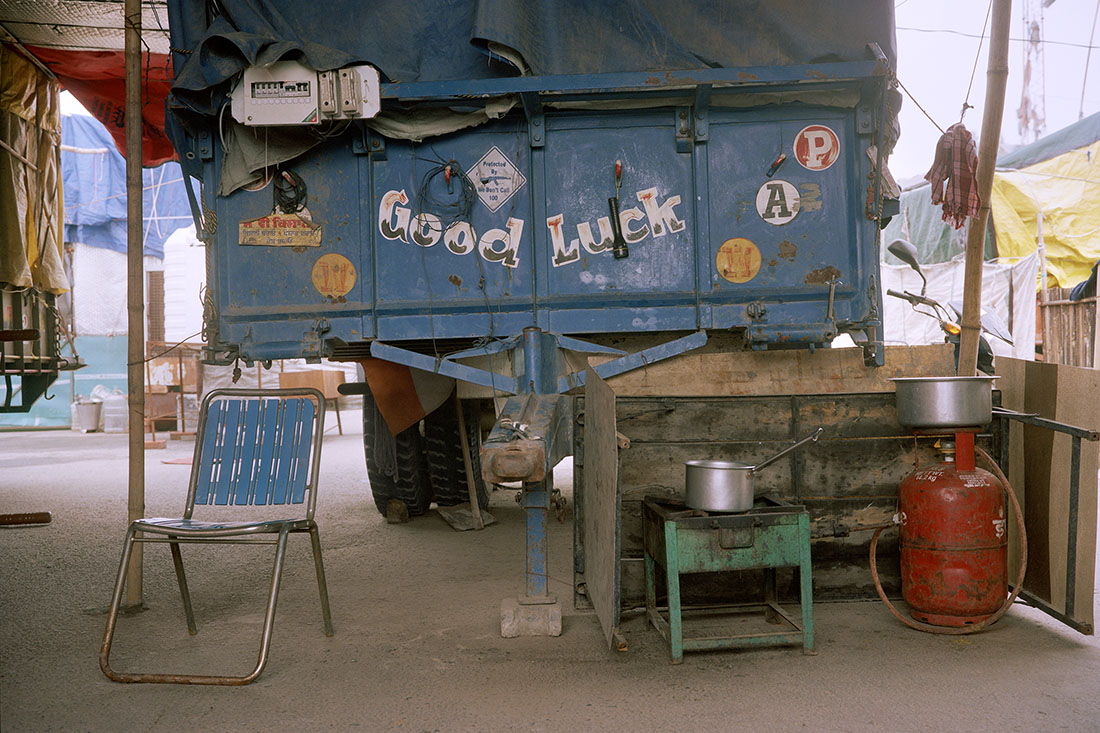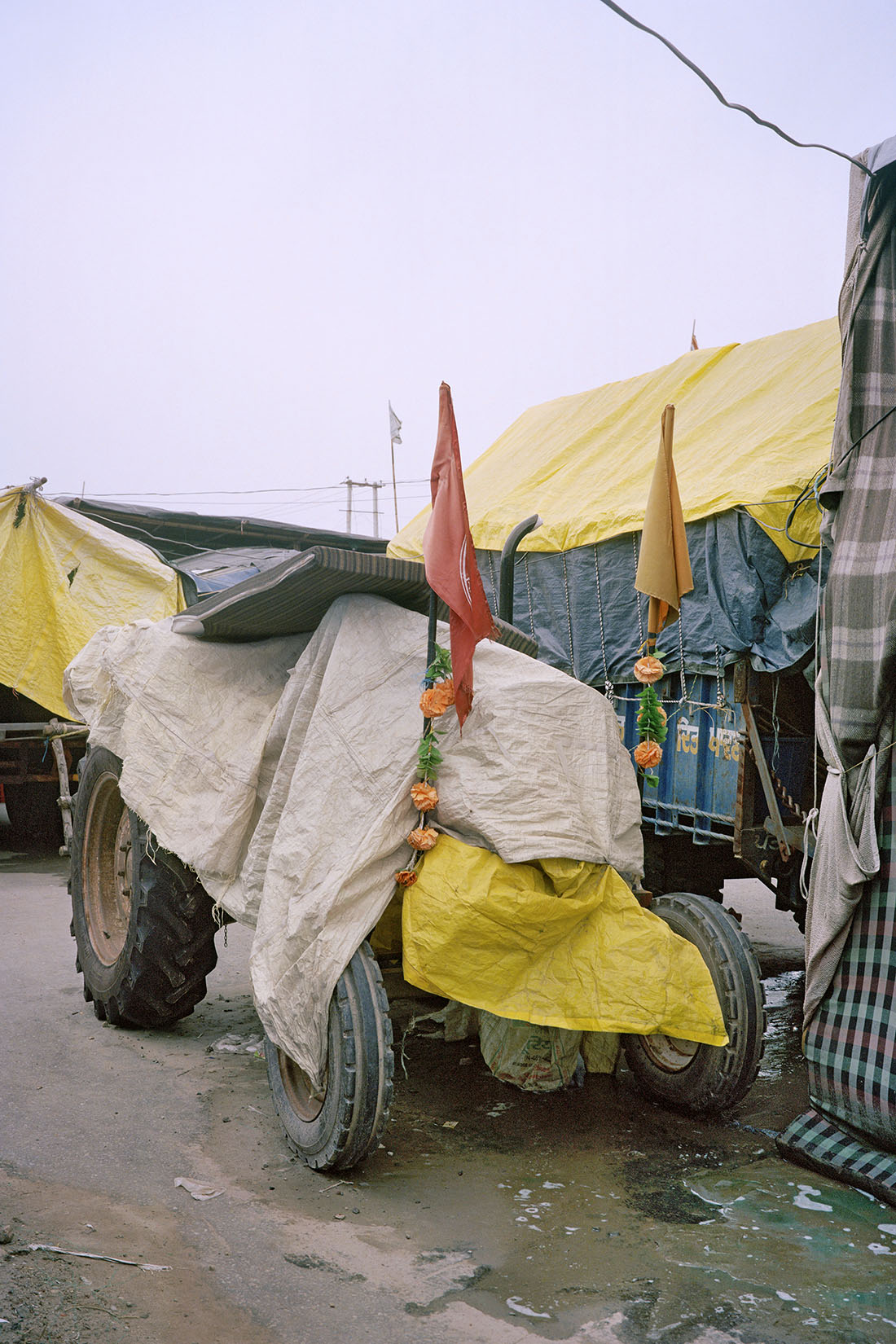The glint from all that metal was distracting speakers on the stage. It was like someone was flashing the sun’s rays off a mirror into your eyes. It took us some moments to realise that these were medals decorating the uniforms of dozens of retired military men, ranging from Lance naiks (lance corporals) to colonels and brigadiers. These were war heroes of the Indian Army.
And they were there as farmers.
They were also there as protestors, alongside thousands of other peasants in Singhu village, on Delhi’s border with the state of Haryana. This was one among five main camps, temporary homes to tens of thousands of cultivators gathered at India’s capital to demand the withdrawal of three ‘Farm Laws’ imposed by the Union Government a few months earlier.

Put simply, the three laws changed the whole landscape for farmers selling their goods in India. They circumvented state-regulated mandis, or wholesale markets, where farmers were assured of a Minimum Support Price (MSP). To replace these markets, there would be a system of direct contracts between producers and retailers/corporations – a contractual relationship that the farmers believed would inevitably favour large conglomerates over small producers. Finally, the laws made sweeping changes to previous provisions that prevented hoarding and price gouging, measures put in place to protect food supplies in a country with a history of widespread food shortages.
The farmers’ struggle on Delhi’s borders began on 24 November 2020, and would last over a year. It was biggest, longest-sustained, democratic, and largely peaceful, protest against economic inequality – and demanding justice – that the world has seen in decades. Certainly, the largest organised at the height of the Covid-19 pandemic, with all its attendant risks. The 2011 Occupy Wall Street movement in New York drew thousands of supporters, but only a few hundred stayed night after night. It lasted nine weeks before they were all turfed out of Zuccotti Park in November that year.
The protestors around Delhi – mostly people from the Indian states of Punjab and Haryana but with sizeable solidarity contingents of farmers from 20 other Indian states – held out a year and two weeks. There was a huge presence of women. And these protestors refused to be turfed out. They left only when the government caved in and accepted their main demand: it withdrew the laws that would have dismantled state-regulated mandis (marketplaces) and transferred huge wealth from the farmers to some of India’s biggest private corporations.
In the 54 weeks in their own ‘Occupy’ camps the farmers – many whole families – endured one of Delhi’s worst winters in decades, followed by a miserable summer, and then terrible rains. Most of that period saw Covid rage ferociously across the land. The communities in the camps sometimes represented entire villages, men, women and children. They set up shelters with their own hands and tools. More often they simply converted their tractors, vans and other vehicles into makeshift refuges. Both the architecture and the ambience of their defiant ‘townships’ was helped by artists, mechanics, masons and small merchants who joined in solidarity.

Still, many had to sleep in the open, or in the tractors they’d driven down in. In metal trolleys at temperatures of 2 degrees Celsius (35.6F). Thousands, in that winter of 2020 – 21, bathed in the open in temperatures of 5 – 6°C (41–43F).
They set up a supply chain for produce, which came flowing in from Punjab and Haryana. These were, after all, farmers, food growers to the nation. Their langars (communal free kitchens) not only fed the thousands in the camps but also countless numbers of homeless people who came there for food. Many farmers from other states worked as volunteers in the open kitchens in some camps, so did many students, teachers and labour union workers. One unforgettable memory: farmers – food growers – in the free kitchens feeding the police and other security personnel sent out to impede them by force. A spectacle of brutality and generosity, of diversity, determination, and democracy, at work.
When they first arrived near Delhi, they had to fight pitched battles with police and security personnel who would not allow them to enter the capital. Then, the authorities cut off their water and electricity, exposing them to dangerously insanitary conditions and health hazards. Early on, they were barricaded in wherever they were, and journalists struggled to reach them. But the protestors overcame each of these hurdles. At terrible cost. When the mammoth protest ended, the coalition of farm unions that spearheaded the battle announced that over 720 people had died over those 54 weeks. Several, apparently, from hypothermia.
It wasn’t just the security forces and government they took on. They were up against some of India’s most powerful corporations – whom the laws favoured, including CEOs ranked among the richest in the world. The farmers were pitted, too, against a hostile corporate-owned media. They were vilified as ‘anti-national’, as secessionists out to destroy India.
‘And think of it,’ laughed one retired colonel, ‘at this very moment, our sons and grandsons are defending your borders.’
He spoke the truth. There are families, particularly from Punjab, Rajasthan, Haryana and Uttarakhand, that have had members in the army for four generations or more. For well over a century, the Indian jawan (soldier) has been a kisan (farmer) in uniform. So it was in 1857, in what British historians are fond of calling the ‘Sepoy Mutiny’, a rebellion of sipahis (soldiers). It was, really, a gigantic agrarian uprising. The vast majority of the soldiers were literally farmers in uniform – recruited from villages – and could not but reflect the mood of their homes. And given the devastation that a century of colonial rule had wrought, that mood was ugly.
In 2020 – 21, it baffled many protestors that their own government might bring in laws that would upend the livelihoods of their people. Besides, beyond their own demands, the farmers were also battling against laws that affected every citizen of India. The laws totally undermined that vital right, so fundamental to democracy, the right to legal remedy.
Try this clause from one of them:
Or another:
Translated from the legalese, the barring of legal remedy becomes clear. Even more startling, though, is the immunity given to ‘any other person.’ Which obviously refers to the corporate giants the farmers would be confronting. Importantly, the immunity granted is not just for actions already taken, but also for those yet to be taken, or ‘intended to be done’.
The laws would have been the final straw that broke the farmers’ backs, but beyond these concerns the farmers were also defending the Constitution of India and its citizens’ right to legal remedy.

Another charge thrown at them by media: these were ‘rich farmers’ from Punjab and Haryana ‘demanding socialism’ for themselves.
Sure, the farmers of Punjab are the best off among those in India. But what was their income? Going by the official data available in late 2020: the average monthly income of a farm householdin Punjab was 18,059 Indian rupees, or roughly £188. The average number of people in such households was 5.24. So monthly per capita income, if you choose to look at it that way, was about £35. Lower than the lowest paid employee in India’s corporate sector. A more recent official report shows higher figures, but that monthly per capita figure in Punjab would, at £53, still be nothing to write home about.
Nor did the media and corporations ever once juxtapose those numbers with this reality: the first year of the pandemic saw India add a record 42 billionaires on to the Forbes list, bringing ‘our’ total to 140. As Forbes said, admiringly: ‘The three richest Indians alone have added [emphasis mine] just over $100 billion between them.’ The top 2 of those 3, precisely those the farmers were naming in their slogans, had seen their wealth grow by 129 and 467 per cent respectively.
This in a nation of 95 million (full-time) farmers that remains locked in an ongoing, nightmarish agrarian crisis that has seen close to 400,000 Indian farmers take their own lives in despair since 1995 (the year India began logging data on farmer suicides). There have been a couple of years in the period after 2001 when there was a suicide every 32 minutes.
That crisis isn’t going away anytime soon. Suicides among small farmers have risen across the world these past 30 – 40 years, notably in the farm belt of the United States. Many farmers in the camps around Delhi did understand the crisis of farming to be global: small family farms against corporations that have already seized control of crucial raw materials. They understand that rural life is in retreat everywhere. They understood that they were taking on the mightiest force of our times – corporate power. Across India it is a struggle to survive for the world’s largest body of small landowning farmers, many much poorer than even those of Punjab and Haryana.
‘We know we’re up against a force of far greater firepower,’ said the retired colonel. ‘That doesn’t mean we’re going to lie down and die.’


